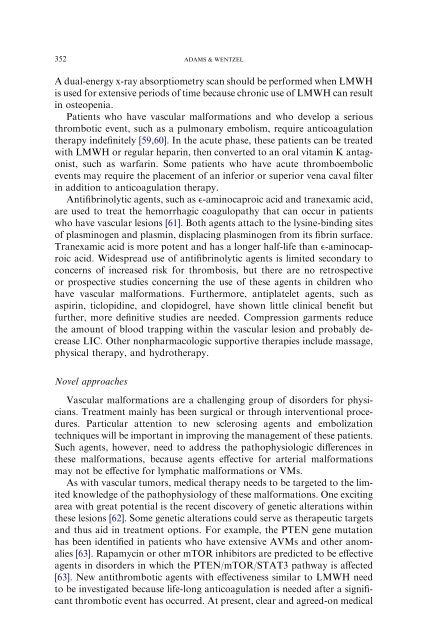Pediatric Clinics of North America - CIPERJ
Pediatric Clinics of North America - CIPERJ
Pediatric Clinics of North America - CIPERJ
You also want an ePaper? Increase the reach of your titles
YUMPU automatically turns print PDFs into web optimized ePapers that Google loves.
352 ADAMS & WENTZEL<br />
A dual-energy x-ray absorptiometry scan should be performed when LMWH<br />
is used for extensive periods <strong>of</strong> time because chronic use <strong>of</strong> LMWH can result<br />
in osteopenia.<br />
Patients who have vascular malformations and who develop a serious<br />
thrombotic event, such as a pulmonary embolism, require anticoagulation<br />
therapy indefinitely [59,60]. In the acute phase, these patients can be treated<br />
with LMWH or regular heparin, then converted to an oral vitamin K antagonist,<br />
such as warfarin. Some patients who have acute thromboembolic<br />
events may require the placement <strong>of</strong> an inferior or superior vena caval filter<br />
in addition to anticoagulation therapy.<br />
Antifibrinolytic agents, such as e-aminocaproic acid and tranexamic acid,<br />
are used to treat the hemorrhagic coagulopathy that can occur in patients<br />
who have vascular lesions [61]. Both agents attach to the lysine-binding sites<br />
<strong>of</strong> plasminogen and plasmin, displacing plasminogen from its fibrin surface.<br />
Tranexamic acid is more potent and has a longer half-life than e-aminocaproic<br />
acid. Widespread use <strong>of</strong> antifibrinolytic agents is limited secondary to<br />
concerns <strong>of</strong> increased risk for thrombosis, but there are no retrospective<br />
or prospective studies concerning the use <strong>of</strong> these agents in children who<br />
have vascular malformations. Furthermore, antiplatelet agents, such as<br />
aspirin, ticlopidine, and clopidogrel, have shown little clinical benefit but<br />
further, more definitive studies are needed. Compression garments reduce<br />
the amount <strong>of</strong> blood trapping within the vascular lesion and probably decrease<br />
LIC. Other nonpharmacologic supportive therapies include massage,<br />
physical therapy, and hydrotherapy.<br />
Novel approaches<br />
Vascular malformations are a challenging group <strong>of</strong> disorders for physicians.<br />
Treatment mainly has been surgical or through interventional procedures.<br />
Particular attention to new sclerosing agents and embolization<br />
techniques will be important in improving the management <strong>of</strong> these patients.<br />
Such agents, however, need to address the pathophysiologic differences in<br />
these malformations, because agents effective for arterial malformations<br />
may not be effective for lymphatic malformations or VMs.<br />
As with vascular tumors, medical therapy needs to be targeted to the limited<br />
knowledge <strong>of</strong> the pathophysiology <strong>of</strong> these malformations. One exciting<br />
area with great potential is the recent discovery <strong>of</strong> genetic alterations within<br />
these lesions [62]. Some genetic alterations could serve as therapeutic targets<br />
and thus aid in treatment options. For example, the PTEN gene mutation<br />
has been identified in patients who have extensive AVMs and other anomalies<br />
[63]. Rapamycin or other mTOR inhibitors are predicted to be effective<br />
agents in disorders in which the PTEN/mTOR/STAT3 pathway is affected<br />
[63]. New antithrombotic agents with effectiveness similar to LMWH need<br />
to be investigated because life-long anticoagulation is needed after a significant<br />
thrombotic event has occurred. At present, clear and agreed-on medical





